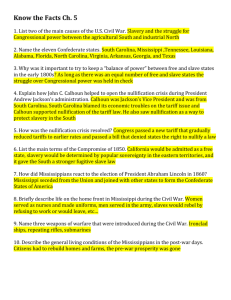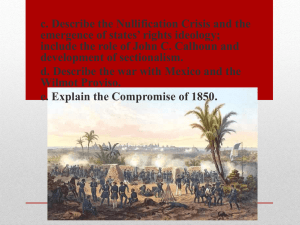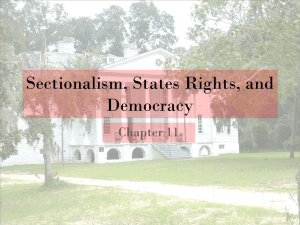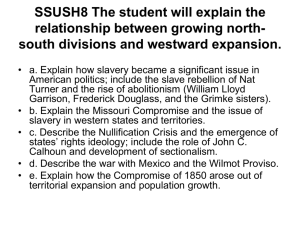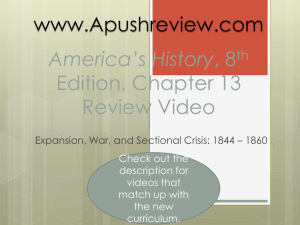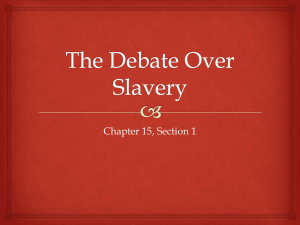SSUSH8 - LessonPaths
advertisement
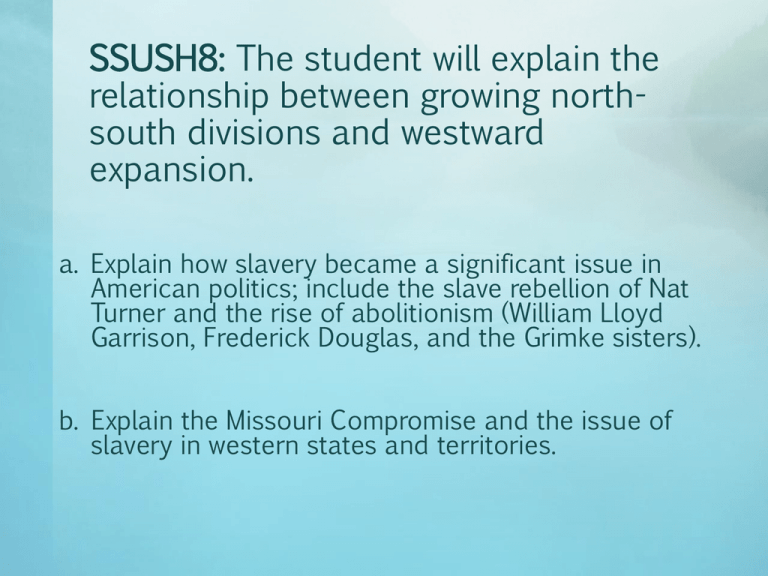
SSUSH8: The student will explain the relationship between growing northsouth divisions and westward expansion. a. Explain how slavery became a significant issue in American politics; include the slave rebellion of Nat Turner and the rise of abolitionism (William Lloyd Garrison, Frederick Douglas, and the Grimke sisters). b. Explain the Missouri Compromise and the issue of slavery in western states and territories. What was the role of slavery in the Southern economy? • The South was mainly agricultural with little manufacturing. • The main crops during the mid 1800s were rice and cotton, both which required extensive labor to produce. • Though slavery was prevalent in the South, the majority of Southerners did not own slaves. What were the results of Nat Turner’s Revolt (1831)? Slave Codes put restrictions on slaves, preventing them from learning to read and write. Nat Turner, a Virginia slave, believed God had chosen him to lead a revolt. Turner and his followers killed more than 50 people before being caught. Turner’s Revolt led to states passing even stricter codes and restrictions on slaves. Who were some of the leading abolitionists of the period? • Grimke Sisters: South Carolina sisters who moved north to promote the abolitionist movement. • William Lloyd Garrison became one of the country’s leading abolitionist, publishing the pro-abolitionist newspaper the Liberator. • Frederick Douglass, a former slave, published the newspaper the North Star and an autobiography. What was the purpose of the Missouri Compromise? • In 1819 the U.S. consisted of 11 free and 11 slave states. • Missouri applied for statehood as a slave state in 1819. • To off set the imbalance, Maine applied for statehood as a free state. • The MC granted statehood to both and set a boundary in which areas slavery could expand into. 36 30 latitude line. Why would the South agree not to expand slavery into the Unorganized Louisiana Territory? c. Describe the Nullification Crisis and the emergence of states’ rights ideology; include the role of John C. Calhoun and development of sectionalism. d. Describe the war with Mexico and the Wilmot Proviso. e. Explain the Compromise of 1850. How was the Nullification Crisis an example of sectionalism? • In the early 1800s South Carolina’s economy began to weaken in part due to high government tariffs, or taxes, on imports. • In 1828 Congress passed another tariff, which many called the Tariff of Abominations. • South Carolina threatened to secede over the high tariffs. Why would tariffs hurt Southern states like South Carolina more than Northern States? How was the Nullification Crisis an example of sectionalism? Vice-President John C. Calhoun, from South Carolina, supported the idea of nullification, or the right of the states to declare federal laws null, or void. He declared that states had this power of nullification because the states had created the federal government. How was the Nullification Crisis an example of sectionalism? • In 1832, Congress passed yet another tariff. • In November 1832, South Carolina declared the tariffs null, and refused to pay the federal government’s taxes on imports. How was the Nullification Crisis an example of sectionalism? • President Andrew Jackson ordered a warship to Charleston, viewing the nullification as a treasonous act. • To ease tensions, Congress passed a bill that gradually lowered tariffs. • South Carolina repealed its nullification of tariffs and the issue was temporarily solved. How was the Nullification Crisis an example of sectionalism? What caused the US to go to war with Mexico? • James Polk became President in 1845, promising to annex Texas and Oregon. • The U.S. annexes Texas, causing a boundary dispute with Mexico. • Polk ordered the army into the disputed area-Mexican troops open fire on the Americans. • Polk then declared war on Mexico, claiming they were the aggressor. What caused the US to go to war with Mexico? • The American army is ordered into Mexico, and out to California. • Before the troops can reach California, a group of American settlers revolt and take the area naming it the Bear Flag Republic. • In 1847, the U.S. Army enters Mexico City causing the Mexicans to surrender ending the war. What did the US gain from winning the war? • Treaty of Guadalupe Hidalgo ended the war, giving the U.S. a vast amount of land in the Southwest. • The U.S. now stretched from the Atlantic to the Pacific Ocean. Why would this treaty cause problems with the Slavery issue? How was the Wilmot Proviso connected to the Mexican War? • Proposed in 1846, that any territory gained from Mexico would not be allowed to have slaves. • The proposal upset Southerners, and though it passed in the House, the Senate refused to vote on it. • The Wilmot Proviso continued north-south sectionalism over the slavery issue. Why was the Compromise of 1850 necessary? To counter the Wilmot Proviso and to ease tension, a proposal was made to allow the new territories to decide for themselves on the slavery issue, an idea called popular sovereignty. California applied for statehood in 1849, threatening to break the balance of free and slave states. Henry Clay proposed a resolution which became known as the Compromise of 1850. Why was the Compromise of 1850 necessary? • Though the Compromise initially had little support, it was passed, by dividing it into smaller bills, allowing Congress to vote on each issue separately easing the tension over slavery.
